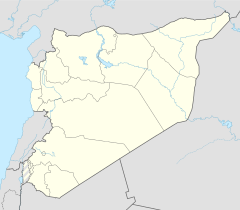Qasr al-Hayr al-Gharbi
| Qasr al-Hayr al-Gharbi قصر الحير الغربي |
|
|---|---|

Qasr al-Heer al-Gharbi
|
|
|
Location within Syria
|
|
| General information | |
| Country | Homs Governorate, Syria |
| Coordinates | 34°22′28″N 37°36′21″E / 34.374444°N 37.605833°E |
Qasr al-Hayr al-Gharbi castle or qasr (Arabic: قصر الحير الغربي), located 80 km south-west of Palmyra on the Damascus road in Syria, is a twin palace of Qasr al-Hayr al-Sharqi, built by the Umayyad caliph Hisham ibn Abd al-Malik in 727 CE. It was built in the Byzantine architectural style.
It was used as an eye of the king during the Umayyad era, to control the movement of the desert tribes and to be a barrier against them, as well as being a hunting lodge. Later it was utilized by the Ayyubids and the Mamelukes but was abandoned permanently after the Mongol invasions.
The castle is quadrangular in outline with 70-meter sides. The central doorway to the castle is very attractive, and has been moved to the National Museum of Damascus to be used as the entrance. Its semi-cylindrical towers on the sides of the doorway, columns, and the geometric shapes mirrored a blend of Persian, Byzantine and Arab architecture.
Not much remained from the castle. Only visible is a reservoir to collect water from Harbaka dam, a bath and a khan.
The gateway is preserved as a façade in the National Museum of Damascus.
Coordinates: 34°22′28″N 37°36′21″E / 34.37444°N 37.60583°E
...
Wikipedia

